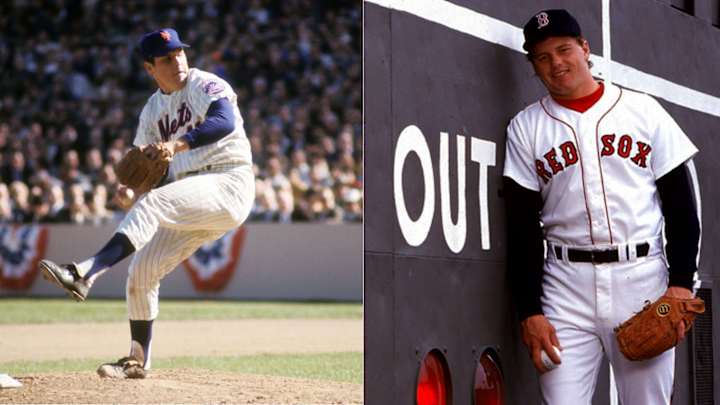Roger Clemens Reflects on All He Learned From Tom Seaver

The baseball community continues to mourn the loss of Hall of Fame pitcher Tom Seaver, who died Monday at the age of 75, leaving behind a legacy that will long outlast his time on the diamond.
“When I think of Tom Seaver, I think of the ultimate power pitcher,” says Roger Clemens, who shared the clubhouse with Seaver as teammates on the Red Sox during the final four months of the 1986 season. “I was so young then, only 23, and Tom was 41, but he was still pretty special. I used to watch as he would change speeds, change locations and use both sides of the plate. Tom made a 17-inch plate into 24 inches.”
Seaver was traded from the White Sox to the Red Sox for “Psycho” Steve Lyons that June. On July 1, Seaver pitched his first-ever home game at Fenway Park—becoming the first 300-game winner to pitch for Boston since Lefty Grove had done so 45 years earlier—and tossed seven innings in a win against the Blue Jays. Clemens was handed the ball the next day, a moment that still stands out in his mind.
“I got to stand on the same mound as someone I looked up to,” says Clemens. “He pitched really well for us, and he went deep into his games. Seaver’s years in the majors were so different. Think about those complete games." (Seaver threw 231 complete games in his 20 seasons.) "Now you have guys looking over their shoulder after the fifth inning. Guys of his era wanted to finish what they started. You’re never going to see that again.”
Clemens won his first Cy Young Award in ’86, a season when his Red Sox were an out away from a World Series victory against the Mets. Seaver’s season ended prematurely when he suffered a ligament tear in his right knee during a game in September. Had he stayed healthy, he would have pitched against the Mets in the World Series.
“It sure would have been fun for him to pitch in the World Series at Shea Stadium,” says Clemens. “That was his stomping grounds. Even though he wasn’t active, it was still great to have a guy with supreme veteran experience there with you. He meant a lot to [left-handed pitcher] Bruce Hurst, too. He and Hursty really hit it off.”
Seaver will forever be associated with the Mets. He was the National League Rookie of the Year in 1967 and won the National League Cy Young Award in the fateful 1969 season, which is when he helped lead the “Miracle Mets” to one of the most remarkable World Series championships in the history of baseball.
Before the Mets’ walk-off home run victory against the Yankees on Thursday, each Met paid tribute to Seaver by rubbing dirt on his right pant leg in honor of his iconic drop-and-drive delivery.
“Back then, when Tom pitched, there was no restriction on the mound’s height,” says Clemens. “That’s why he would drop-and-drive, getting that back knee dirty, and still be able to create an angle toward home plate. It was fun to watch him pitch. Just to be able to watch him, how he’d work his way through men on base, I learned a big difference in how to approach the game.
"Another part that made it so great was our pitching coach, Bill Fischer, who also had Seaver for a few years in Cincinnati," says Clemens. "They were an incredible combination. Before I’d met Tom, Fish had been on the phone with Tom a handful of times, telling him all about my [14-0] start in ’86. He said, ‘Tom, you need to see this kid.’ So Tom had known who I was, and I loved talking with him.”
Clemens absorbed knowledge from Seaver that stuck with him for the remainder of his career.
“Tom had the gift of keeping things really simple when it came to pitching,” says Clemens. “I still remember him telling me, ‘Don’t let anybody mess with your mechanics. The way they are, they’ll carry you a long way.’ I remember telling him about three or four of my hot spots, and the knowledge he gave me back was invaluable. It had nothing to do with analytics, nothing crazy like that, it was real simple stuff—but stuff you need to have to pitch in the major leagues.
“And I learned so much from watching his side sessions. I’d go on to tell people that my only day off was the day I would pitch, and I learned that from Seaver when I watched his bullpens. He didn’t have to throw 60 pitches, he would throw 20–30 pitches real sharp. A breaking ball here and there, work in that changeup, and he was ready for his next start. I was amazed at his routine.”
As baseball weeps for its loss, Clemens reflected back on the dignity, grace and poise of one of the greatest pitchers to ever play the game.
“I’ll remember his work-like attitude,” says Clemens. “He loved going to work and playing baseball. I like to think he’s now with Fish, talking mechanics and happy to be together again with an old friend.”
Justin Barrasso can be reached at JBarrasso@gmail.com. Follow him on Twitter @JustinBarrasso.
